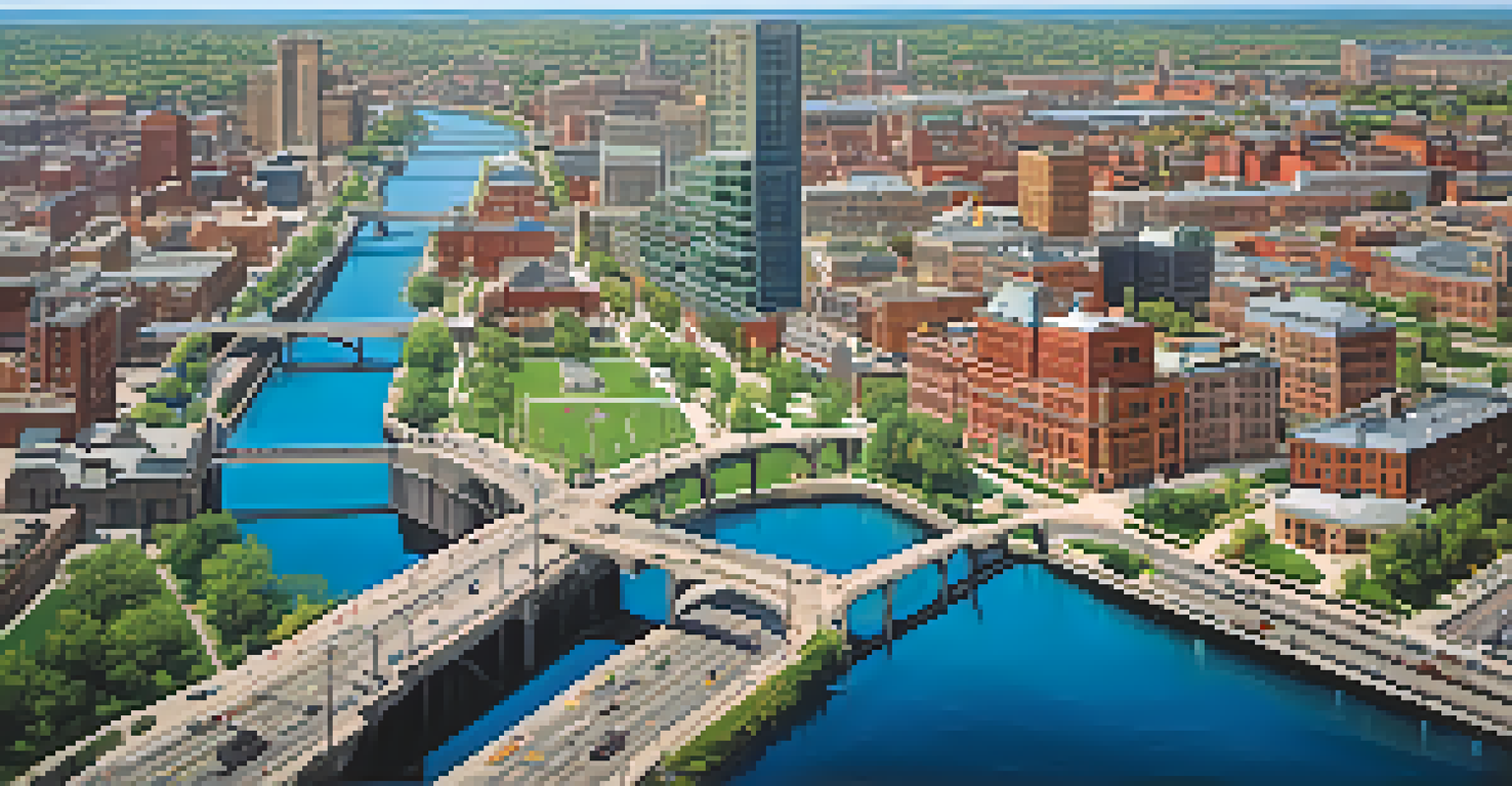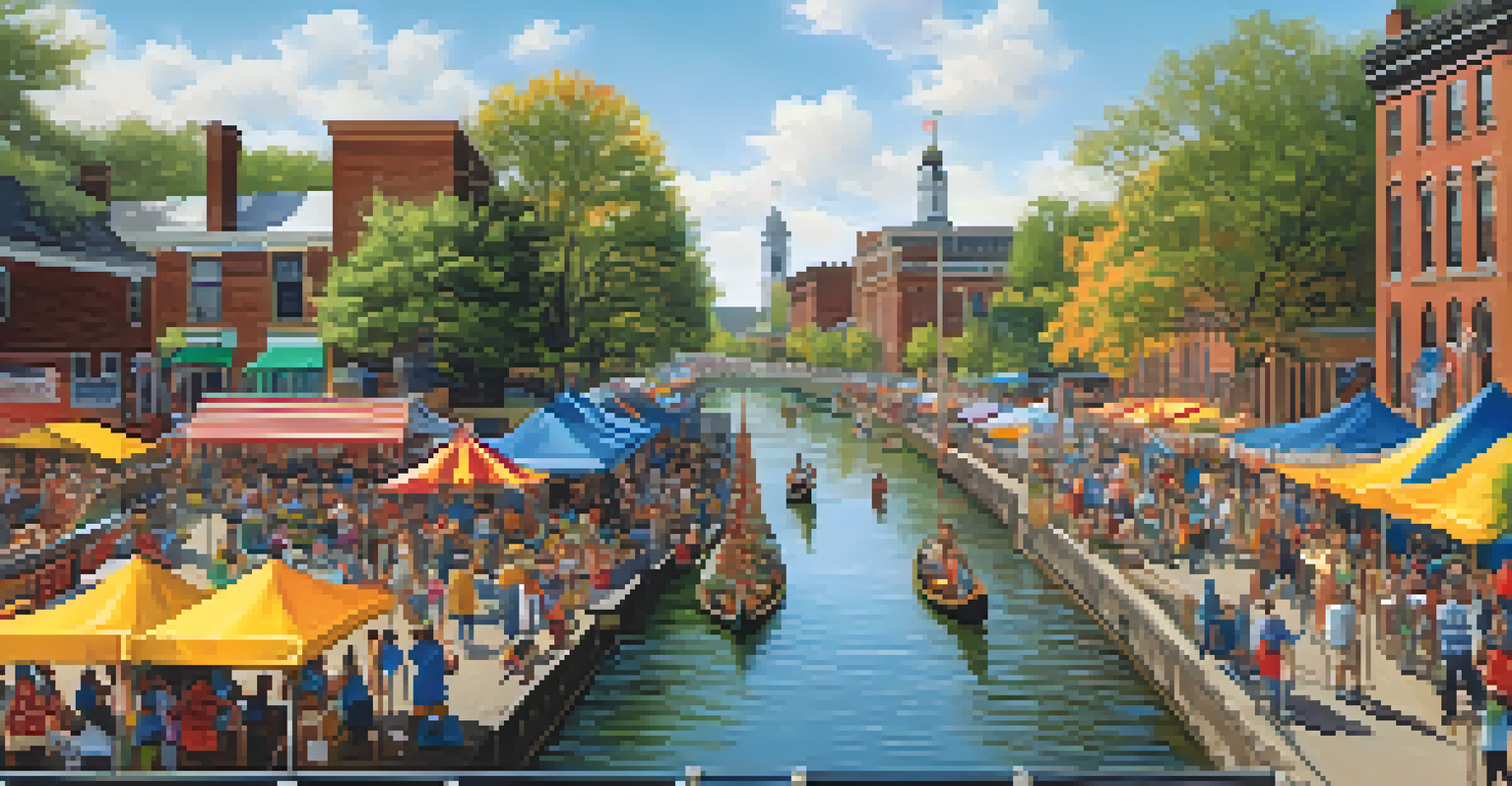The Erie Canal's Role in Shaping Buffalo's Urban Landscape

The Erie Canal: A Game Changer for Buffalo
Completed in 1825, the Erie Canal was a monumental engineering feat that connected the Hudson River to Lake Erie. For Buffalo, this meant direct access to the Atlantic Ocean, opening up trade routes that would invigorate the local economy. As a result, Buffalo quickly became a bustling hub for commerce and transportation, attracting businesses and settlers alike.
The Erie Canal is a monument to the power of human ingenuity and the importance of infrastructure in shaping communities.
The canal's establishment turned Buffalo into a critical port city, where goods like grain and lumber flowed in and out. This influx of resources not only boosted local industries but also laid the groundwork for a diverse economy. The city transformed from a sleepy village into a thriving urban center almost overnight, showcasing the profound impact of infrastructure on urban growth.
Additionally, the Erie Canal fostered a sense of community among its residents. As people moved to Buffalo for work and opportunity, neighborhoods began to form, each with its own unique character. The social fabric of the city grew richer, and the canal became a vital artery connecting the lives of Buffalonians.
Economic Growth and Industrialization
The Erie Canal was more than just a waterway; it was the lifeblood of Buffalo's economy. It facilitated the movement of goods at a fraction of the cost of overland transport, which attracted manufacturers to the region. Industries such as grain milling and shipbuilding flourished, creating thousands of jobs and stimulating growth.

As Buffalo's economy boomed, the demand for housing and services skyrocketed. This led to the construction of warehouses, factories, and residences, transforming the urban landscape. The city became a melting pot of cultures, as workers from various backgrounds came together to build their lives in this newfound economic paradise.
Erie Canal Transformed Buffalo's Economy
The Erie Canal's completion in 1825 turned Buffalo into a bustling hub for commerce, significantly boosting local industries and attracting settlers.
This wave of industrialization also prompted advancements in technology and infrastructure. The need for better roads, railroads, and transportation systems became apparent, leading to further investments in urban development. As a result, Buffalo evolved into a modern city with the amenities and services necessary to support its growing population.
Cultural Shifts Driven by Canal Development
With economic growth came cultural shifts that significantly shaped Buffalo's identity. The Erie Canal attracted immigrants from various countries, each bringing unique traditions, foods, and languages. This cultural diversity enriched the city's social landscape and fostered a sense of community among its residents.
Canals are the arteries of commerce and the lifeblood of cities, connecting places and people in profound ways.
Festivals, parades, and community gatherings became common, reflecting the vibrant mix of cultures. The canal itself became a focal point for recreational activities, with families enjoying picnics along its banks or taking boat rides. Such events helped solidify Buffalo's reputation as a lively and welcoming city.
As neighborhoods developed, cultural institutions like theaters, museums, and libraries began to emerge. These spaces not only served educational purposes but also became hubs for artistic expression, further enhancing the quality of life in Buffalo. The canal was not just a waterway but a catalyst for cultural evolution.
Urban Planning and Infrastructure Expansion
The rapid growth spurred by the Erie Canal necessitated thoughtful urban planning. City leaders recognized the importance of creating a well-structured environment to accommodate the influx of residents and businesses. This led to the establishment of parks, streets, and public spaces that defined Buffalo's urban landscape.
As Buffalo expanded, the need for efficient transportation networks became essential. The canal played a pivotal role in this by inspiring the development of streetcar systems and railroads that connected different parts of the city. This infrastructure not only facilitated commerce but also improved access to education and healthcare.
Cultural Diversity Flourished
The influx of immigrants drawn by economic opportunities enriched Buffalo's cultural landscape, leading to vibrant community events and institutions.
Moreover, the emphasis on urban planning ensured that Buffalo could sustain its growth over the long term. Parks and green spaces were integrated into the city design, promoting a healthy and vibrant community. The foresight of city planners helped Buffalo maintain its charm while accommodating modern needs.
Environmental Impact of the Erie Canal
While the Erie Canal brought many benefits to Buffalo, it also had significant environmental implications. The construction of the canal altered the natural landscape, affecting local ecosystems and waterways. Wetlands were drained, and habitats were disrupted, leading to changes in the area's biodiversity.
However, the canal also presented opportunities for environmental stewardship. As the city grew, so did awareness of the need to protect natural resources. Initiatives to clean up the canal and restore surrounding areas emerged, showcasing how urban development can coexist with conservation efforts.
Today, the canal's restoration and revitalization are seen as key components of Buffalo's urban strategy. Parks and recreational areas along the canal now serve as green lungs for the city, promoting ecological balance while providing residents with beautiful spaces to enjoy nature. This ongoing relationship between urban growth and environmental care is a testament to Buffalo's adaptability.
The Erie Canal's Legacy in Modern Buffalo
The legacy of the Erie Canal is still evident in Buffalo today. While its commercial importance has diminished, the canal remains a symbol of the city's rich history and resilience. Efforts to revitalize the canal and its surroundings continue, reflecting a commitment to preserving this vital piece of Buffalo's identity.
Modern Buffalo has embraced its canal heritage, using it as a focal point for tourism and recreation. The waterfront areas have been developed into vibrant spaces for locals and visitors alike, featuring walking paths, parks, and cultural events. This has helped to bridge the past with the present, making Buffalo a dynamic place to live and explore.
Legacy of Urban Planning and Growth
Buffalo's rapid expansion due to the canal's impact prompted thoughtful urban planning, ensuring a sustainable and livable city for future generations.
Moreover, the canal's history serves as a reminder of the importance of infrastructure in shaping urban landscapes. As Buffalo continues to grow and evolve, the lessons learned from the Erie Canal's impact will guide future development efforts, ensuring that the city honors its past while building for a sustainable future.
Conclusion: The Enduring Impact of the Erie Canal
In conclusion, the Erie Canal has played a pivotal role in shaping Buffalo's urban landscape, impacting its economy, culture, and environment. From a small port town to a thriving urban center, Buffalo's transformation is a testament to the canal's influence. The interwoven stories of growth, diversity, and innovation continue to define the city today.
As we reflect on the past, it's essential to recognize the ongoing efforts to preserve the canal's legacy while adapting it for future generations. Buffalo's commitment to balancing development with environmental stewardship is a model for cities around the world. The preservation of green spaces and waterways is crucial for enhancing the quality of life for residents.

Ultimately, the Erie Canal serves as both a historical landmark and a catalyst for progress in Buffalo. Its enduring impact reminds us of the power of infrastructure in shaping urban landscapes and the communities that inhabit them. As Buffalo looks to the future, the lessons learned from the canal's history will undoubtedly continue to inspire growth and resilience.